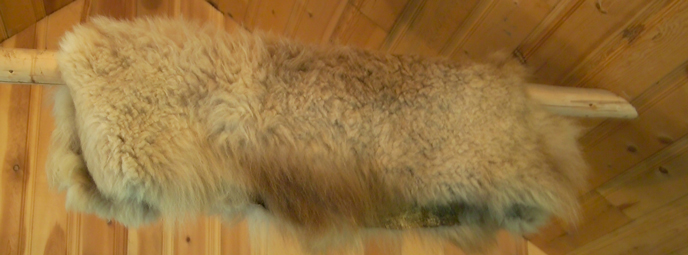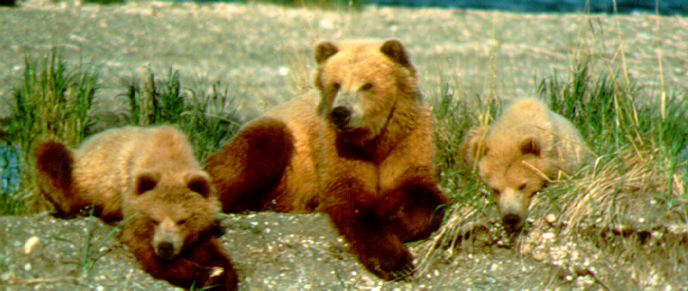
In the Brooks Camp Visitor Center, a bear pelt hangs in the rafters. This pelt belonged to a young female bear nicknamed Sister. After obtaining food and equipment from people, Sister became the last bear destroyed at Brooks Camp. This is a story of mistakes and loss. It teaches a lesson that we should never learn the hard way again.
The Story
On July 6th, 1982, a sow with two cubs obtained fish, as well as a backpack containing additional fish, from a group of anglers. This was the first in a series of incidents that summer in which a sow with two cubs obtained food and gear from people in the vicinity of Brooks Camp.
Later on the same day, a sow with two cubs damaged an airplane float containing several fish. On July 23rd, a sow with two cubs was in the area immediately after an unidentified bear pulled five packs from the elevated storage area in the Brooks Camp campground. Six days later, on July 29th, a sow with two cubs took an unattended bag of flour from a skiff in which food was being stored. Almost month later, there was another incident involving a female with two cubs, when the sow took two backpacks from an unattended canoe.
From a bear's perspective, getting food from people is a strong reward. It greatly increases the likelihood the bear will do it again and become a threat to human safety. Bears have good memories, and the sow's behavior in 1983 was consistent with what she learned in 1982.
On June 12th, 1983 at 11:00 AM, two people were fishing in the upper Brooks River and observed a light brown sow with two yearlings on the bank. The anglers moved farther into the river. The bears advanced toward them and then resumed walking downstream. Around 12:00 noon, a sow and her two yearlings were observed, without incident, within 10 feet of an occupied tent. At 12:30 PM, a sow with two young approached to within 15 feet of two people who were sitting on a rock in upper Brooks River. They had left an unattended daypack on the trail by the river. The daypack contained no food, but the bears picked up a camera, nosed the pack, and looked at the two people for a few minutes before moving off downstream.
Later that same afternoon at about 1:00 PM, the two anglers who had met the bears at 11:00 AM stopped to have a picnic lunch beneath the platform at Brooks Falls. They looked up and saw a sow with two yearlings nearby and moving toward them. They abandoned their food and moved away. Before they left the area, the anglers watched as the bears ate their abandoned food.
At about 2:30 pm, two people were fishing in the oxbow area of Brooks River. They saw a female with two yearlings downstream of them. The bears were moving upstream along the shore towards them. The anglers moved to the opposite shore, and the bears crossed the river and continued to approaching them. The anglers moved back into the river, and the bears followed. The anglers crossed the river and climbed up a steep, eroding hillside. One of them had difficulty. He reached a snag in the bank and was being hoisted up by the other person just as the sow reached the snag. Fortunately, the sow also had difficulty in getting past the snag. The two people continued moving away and the three bears crossed the river and disappeared into the vegetation.
The next day, June 13th, 1983, a sow with two yearlings damaged two tents, as well as a backpack, a duffle bag, and a sleeping bag in the campground around 2:00 PM. None of these items contained any food, but the sow's behavior was becoming a danger to human safety. Park rangers made a difficult decision.
The Consequences
On June 13th, the decision was made to destroy the sow, who had repeatedly obtained food and gear rewards from humans. The Alaska Department of Fish and Game concurred that it was necessary for defense of life and property.
Around 3:00 PM on June 14th, 1983, a park ranger was on the north bank of Brooks River and saw the sow with two yearlings about 100 yards upstream. The ranger began moving downstream, and the bears disappeared into the vegetation. A person on a vantage point thought he saw the bears in the vegetation moving toward the ranger, so he radioed a warning to the ranger. The ranger jumped to an island in the river just as the sow stepped out of the vegetation at the spot where the ranger had been. The ranger crossed the river and the sow moved to the island, but did not cross the river.
The bears then moved downstream to the oxbow, where they picked up the scent of garbage that had just been placed in the area to attract them. They moved directly to the bait, where the sow was killed by rangers. The yearling cubs were hazed away and left the area. Examination of the female's carcass showed she was in excellent general condition.

As a direct result of people acting carelessly, the bear nicknamed Sister (center) was killed in defense of life and property in 1983.
The Lesson
With Sister, one incident in 1982 led to a cascading series of events in which the bear family's behavior was reinforced again and again with food like fish and play rewards like tents and backpacks. This bear's fate was entirely preventable. She was just being a bear. It was the mistakes of humans that led to the female's death.
Bears are smart animals that are quick to learn, especially when their behavior is reinforced with the reward of food. The experiences of this female and her cubs in 1982 led the female's death in 1983. Often, it only takes one person's mistake for a bear to learn to associate people with food.
In the years since the death of this bear, Brooks Camp has experienced a remarkable safety record even with increasing numbers of people and bears along the Brooks River. Food storage, gear storage, and fishing regulations have been tightened to minimize the chance that Sister's story will be repeated. However, the lessons we take away from her story are only as good as the actions taken while visiting Katmai.
It is up to everyone—every person who visits Katmai—to keep bears safe. Today, Sister's pelt hangs in the Brooks Camp Visitor Center as a reminder of our mistakes. She taught everyone a lesson and it's a lesson that should never have to be repeated.
